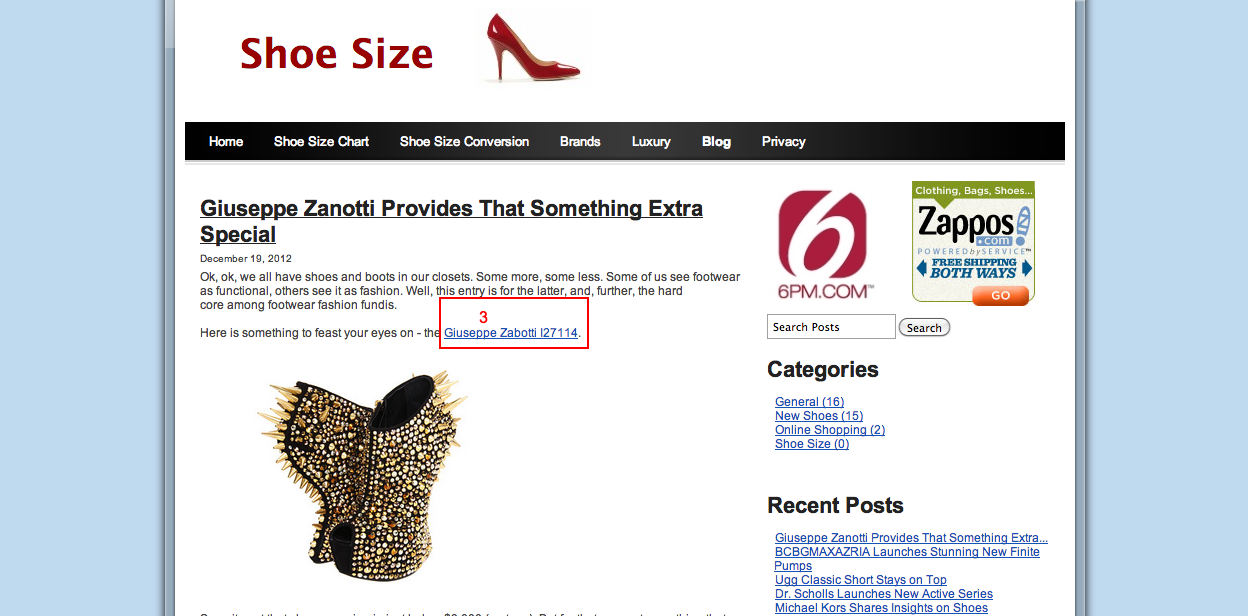Guest post by Michael Leeman, investor and advisor to digital companies in South Africa and the US.
From past experience in the online marketing world, I knew that there was demand for shoe size conversions. It was high value traffic and there was relatively little focused competition. I set up www.shoesizeconverters.com to profit from this demand.
Building the site and purchasing a custom domain were the easy parts. Monetization would be through Google AdSense (very easy to set up through the Yola Sitebuilder) and affiliate links to Zappos.com via Commission Junction. What I needed was traffic.

The first few months were filled with expense, frustration and failure. Here’s what happened, and what I learned.
Failure # 1: Paying for Content
Using Google Trends and Google Adwords Traffic Estimator, I identified the highest-traffic related keywords. Then I outsourced some content creation via ELance to create unique content focused on the targeted six Head Keywords, or popular and competitive keywords.
For example, I purchased 500 words relating to “European Shoe Size Conversion,” built a targeted page around this keyword and hoped for the best. Unfortunately, hope is not a strategy, and the focused, expensive content did nothing for the site’s organic search ranking on the targeted Head Keywords.
So, I built it; and they did not come.
Failure # 2: Paying for Traffic on My Head Keywords
The next step was to try and purchase traffic via a Google Adwords campaign. The idea was to buy traffic relatively cheaply on the targeted Head Keywords, paying less than $0.05 per click. These visitors would click on my AdSense ads and the profits would flow.
Unfortunately, the math did not stack up. AdSense revenue was about $0.35 per click with a 2% conversion rate; so 100 clicks earned me $0.70 but cost $5. It could be a matter of SEM optimization.
Failure # 3: Buying Links
I needed organic traffic.
To get this, I needed better search rankings. So, my next idea was to purchase inbound links. After a personal reference and some research, I located a service provider who seemed to have cracked the linking code. It was not cheap, but surely it would be worth it…
As promised, the links produced a major spurt in my search rankings on the six, targeted Head Keywords, and traffic grew – for a very short time. Then the search rankings collapsed again.
Even at the peak rankings, recovering costs would have taken many years. Now I was back to square one – and out of pocket.
The “AHA” Moment via Google Analytics
One of the many great features of the Sitebuilder is the easy integration of Google Analytics. Clutching at straws, I decided to see where my (minimal) traffic was coming from.
Surprisingly, the limited traffic was not coming from the Head Keywords, which were high frequency but competitive. They were dribbling in from brand specific searches (e.g. “Nike Shoe Size Conversion”). I had put a few brand shoe size conversion pages on my site to flesh it out.

Now, they seemed to be getting some traction. So I thought, what if I tried a few more brand specific landing pages?
Success # 1: Grab the Long Tail
Fortunately, there are hundreds of shoe brands. And building new pages is easy with Yola “Save Page As” feature. First, I did the better-known brands (such as Crocs) and then just started going alphabetically. Each page took only a few minutes, and soon I had almost 100 branded show size conversion pages.
The results were astounding.
For the second tier brands, after a few months the site was ranked in the top 5, often at number 1. Although “Chinese Laundry Shoe Size Conversion” has relatively few search queries daily the total traffic grows if you (a) are the top ranked result and (b) you have a hundred similar pages.
My overall site traffic grew from 20 daily visitors to 500+, with steady growth over time as new pages were added.
Success # 2: Deep Affiliate Links
My AdSense revenue was now providing useful pocket money, however the affiliate links were not working. There were simply too few click-throughs for the Zappos display ads.
Solution?
Provide affiliate text links (i.e. “visit Zappos.com for the best prices on Chinese Laundry shoes”). The links directed visitors to the brand specific Zappos page, not the general homepage. Affiliate clicks and sales increased tenfold.
Sustainable Success
The lessons were long and costly, but a winning formula was finally obtained through:
- Organic traffic.
- Relevant long tail content, not dubious inbound links.
- Deep affiliate links.
- Natural SEO improvements as time progressed, since the age of the site is not an important factor.
And with only 5% of shoe brands currently covered by the site, pocket money may be real income some day as I continue to add pages.
__
About Michael Leeman:
After a decade in financial services, Michael entered the world of digital marketing and Internet start ups in 2005 and has remained there ever since. He invests in and advises a range of digital companies in South Africa and the USA. Shoesizeconverters.com is a project used to get first hand information on the intersection of SEO, Paid Search, Adsense and Affiliate Marketing.
Make sure that your website is fully functional, easy to navigate and attractive. Having articles on your website that is relevant to the products or services you offer is a great option.
Pingback: What are keywords and why are they important? | Yola
hi
Pingback: Planning Your Site With SEO in Mind | Yola
Traffic is needed to any blog or site, but it will flow if you have a nice content
http://www.laughterclinic.blogspot.ae/